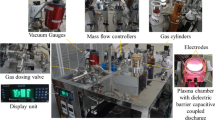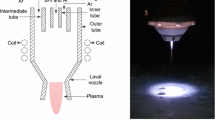Abstract
The rising demand for precision optics widely employed in ground and space-based astronomical instruments and other scientific instrumentation requires highly efficient advanced fabrication methods. Due to complex-shaped fused silica substrate surfaces like freeform or aspheres with strong curvatures or very small-sized components, a novel non-contact medium-pressure plasma-based method is developed to finish optical components. The present study critically compares the polished optical surfaces of a prism with a medium-pressure plasma process and wet chemical etching to provide insight into their smoothing. The results show that surface roughness (Ra) increases from 0.54 to 2.61 nm and 0.53 to 0.57 nm at 5 and 20 mbar total pressures, respectively, using a plasma process without surface contamination. However, wet chemical etching increases surface roughness (Ra) from 0.52 to 15.9 nm. The substrates' surface morphology, elemental composition, and surface topography are analyzed using FESEM, EDX, and AFM. Moreover, subsurface improvements are analyzed using Raman spectroscopy analysis.
















Similar content being viewed by others
Data Availability
Data will be made available on request.
Abbreviations
- FESEM :
-
Field emission scanning electron microscopy
- EDX:
-
Energy dispersive X-ray
- AFM:
-
Atomic force microscopy
- R a :
-
Surface roughness
- UVL:
-
Ultraviolet lithography
- EUVL:
-
Extreme ultraviolet lithography
- APPP:
-
Atmospheric pressure plasma polishing
- RF:
-
Radio-frequency
- PJM:
-
Plasma jet machining
- PAMM:
-
Plasma-induced atom migration manufacturing
- MPPP:
-
Medium-pressure plasma polishing
- MRR:
-
Material removal rate
- LIDT:
-
Laser-induced damage threshold
- OES:
-
Optical emission spectrometer
References
Narayan H, Yadav S, Das M (2023) Experimental investigations through modeling and optimization for fabrication of fused silica in medium-pressure plasma process. Opt Mater 143:114157
Yadav HNS, Das M (2023) Surface characteristics of fused silica in medium-pressure plasma process. Mater Today Proc 1–5
Yadav HNS, Kumar M, Kumar A, Das M (2021) Plasma polishing processes applied on optical materials: a review. J Micromanufacturing 6:251659842110388
Kogelschatz U (2003) Dielectric-barrier discharges: their history, discharge physics, and industrial applications. Plasma Chem Plasma Process 23:1–46
Yadav HNS, Kumar M, Das M (2022) Fundamentals of plasma polishing. In: Jain VK (ed) Advanced machining science. CRC Press, Boca Raton, pp 203–228
Schindler A and Boehm G and Haensel T and Frank W and Nickel A and Rauschenbach B and Bigl F (2001) Precision optical asphere fabrication by plasma jet chemical etching (PJCE) and ion beam figuring. In: Optical manufacturing and testing. p 242‒248
Zhang J, Wang B, Dong S (2008) Analysis of factors impacting atmospheric pressure plasma polishing. Int J Precis Eng Manuf 9:39–43
Dev DSD, Krishna E, Das M (2019) Development of a non-contact plasma processing technique to mitigate chemical network defects of fused silica with life enhancement of He–Ne laser device. Opt Laser Technol 113:289–302
Yadav HNS, Kumar M, Kumar A, Das M (2021) COMSOL simulation of microwave plasma polishing on different surfaces. Mater Today Proc 45:4803–4809
Gerhard C, Weihs T, Luca A et al (2013) Polishing of optical media by dielectric barrier discharge inert gas plasma at atmospheric pressure. J Eur Opt Soc 8:1–5. https://doi.org/10.2971/jeos.2013.13081
Arnold T, Boehm G, Mueller H, et al (2022) Plasma jet assisted polishing of fused silica freeform optics. In: European physical journal web of conferences. p 03001
Gerhard C, Weihs T, Tasche D et al (2013) Atmospheric pressure plasma treatment of fused silica, related surface and near-surface effects and applications. Plasma Chem Plasma Process 33:895–905
Arnold T, Boehm G, Paetzelt H (2015) New freeform manufacturing chain based on atmospheric plasma jet machining. In: Freeform optics. p FTh1B.3
Li R, Li Y, Deng H (2022) Plasma-induced atom migration manufacturing of fused silica. Precis Eng 76:305–313
Suratwala T, Steele W, Wong L et al (2015) Chemistry and formation of the beilby layer during polishing of fused silica glass. J Am Ceram Soc 98:2395–2402. https://doi.org/10.1111/JACE.13659
Dev DSD, Krishna E, Das M (2016) A novel plasma-assisted atomistic surface finishing on freeform surfaces of fused silica. Int J Precis Technol 6:262
Narayan H, Yadav S, Krishna E et al (2023) Investigation of MRR and surface characterization using plasma process. Mater Manuf Process 38:1–13
Narayan H, Yadav S, Das M (2023) Parametric optimisation of plasma polishing process using response surface methodology. Surf Eng 39:1–14
Feit MD, Suratwala TI, Wong LL et al (2009) Modeling wet chemical etching of surface flaws on fused silica. Laser-Induced Damage Opt Mater 7504:75040L. https://doi.org/10.1117/12.836912
Cheng J, Wang J, Hou J et al (2017) Effect of polishing-induced subsurface impurity defects on laser damage resistance of fused silica optics and their removal with HF acid etching. Appl Sci 7:1–23. https://doi.org/10.3390/app7080838
Ye H, Li Y, Yuan Z et al (2015) Laser induced damage characteristics of fused silica optics treated by wet chemical processes. Appl Surf Sci 357:498–505. https://doi.org/10.1016/j.apsusc.2015.09.065
Ye H, Li Y, Yuan Z, Zhang Q (2018) Ultrasonic-assisted wet chemical etching of fused silica for high-power laser systems. Int J Appl Glas Sci 9:288–295. https://doi.org/10.1111/ijag.12332
Yao YX, Wang B, Wang JH, Jin HL, Zhang YF, Dong S (2010) Chemical machining of Zerodur material with atmospheric pressure plasma jet. CIRP Ann 59:337–340
Wang D, Liu W, Wu Y et al (2011) Material removal function of the capacitive coupled hollow cathode plasma source for plasma polishing. Phys Procedia 19:408–411
Al-Hawat S, Polonica MA (2010) Spatial structure of emission intensity in capacitive RF discharge of He: Ne mixture at moderate pressures. Acta Phys Pol 117:911–916
Dev DSD, Enni K, Das M (2018) Novel Finishing process development for precision complex-shaped hemispherical shell by bulk plasma processing. In: Precision product-process design and optimization. pp. 313–335
Xu S, Zu X, Jiang X et al (2008) The damage mechanisms of fused silica irradiated by 355 nm laser in vacuum. Nucl Instrum Method Phys Res Sect B Beam Interact with Mater Atoms 266:2936–2940
Galeener FL, Leadbetter AJ, Stringfellow MW (1983) Comparison of the neutron, Raman, and infrared vibrational spectra of vitreous Si02, GeOz, and BeF2. Phys Rev 8:15
Galeener FL, Geissberger AE (1983) Vibrational dynamics in Si30-substituted vitreous SiO2. Phys Rev B 27:6199–6204
Liu F, Qian J, Wang X et al (1997) UV irradiation-induced defect study of glasses by Raman spectroscopy. Phys Rev B—Condens Matter Mater Phys 56:3066–3071
Acknowledgements
We thank the Science and Engineering Research Board, New Delhi, India, for its financial support of project No. E.C.R./2018/002801 titled "Design and development of a novel plasma processing set up for uniform nanopolishing of prism and any freeform surfaces of fused silica."
Author information
Authors and Affiliations
Contributions
HNSY: Conceptualization, Methodology, Data curation, Investigation, Writing—review & editing. MD: Supervision, Writing—review & editing.
Corresponding author
Ethics declarations
Competing interests
The authors declare no competing interests.
Additional information
Publisher's Note
Springer Nature remains neutral with regard to jurisdictional claims in published maps and institutional affiliations.
Rights and permissions
Springer Nature or its licensor (e.g. a society or other partner) holds exclusive rights to this article under a publishing agreement with the author(s) or other rightsholder(s); author self-archiving of the accepted manuscript version of this article is solely governed by the terms of such publishing agreement and applicable law.
About this article
Cite this article
Yadav, H.N.S., Das, M. Development and Performance Evolution of Medium-Pressure He/SF6/O2-Based Plasma and Wet Chemical Etching Process for Surface Modification of Fused Silica. Plasma Chem Plasma Process 44, 1083–1104 (2024). https://doi.org/10.1007/s11090-024-10447-x
Received:
Accepted:
Published:
Issue Date:
DOI: https://doi.org/10.1007/s11090-024-10447-x




